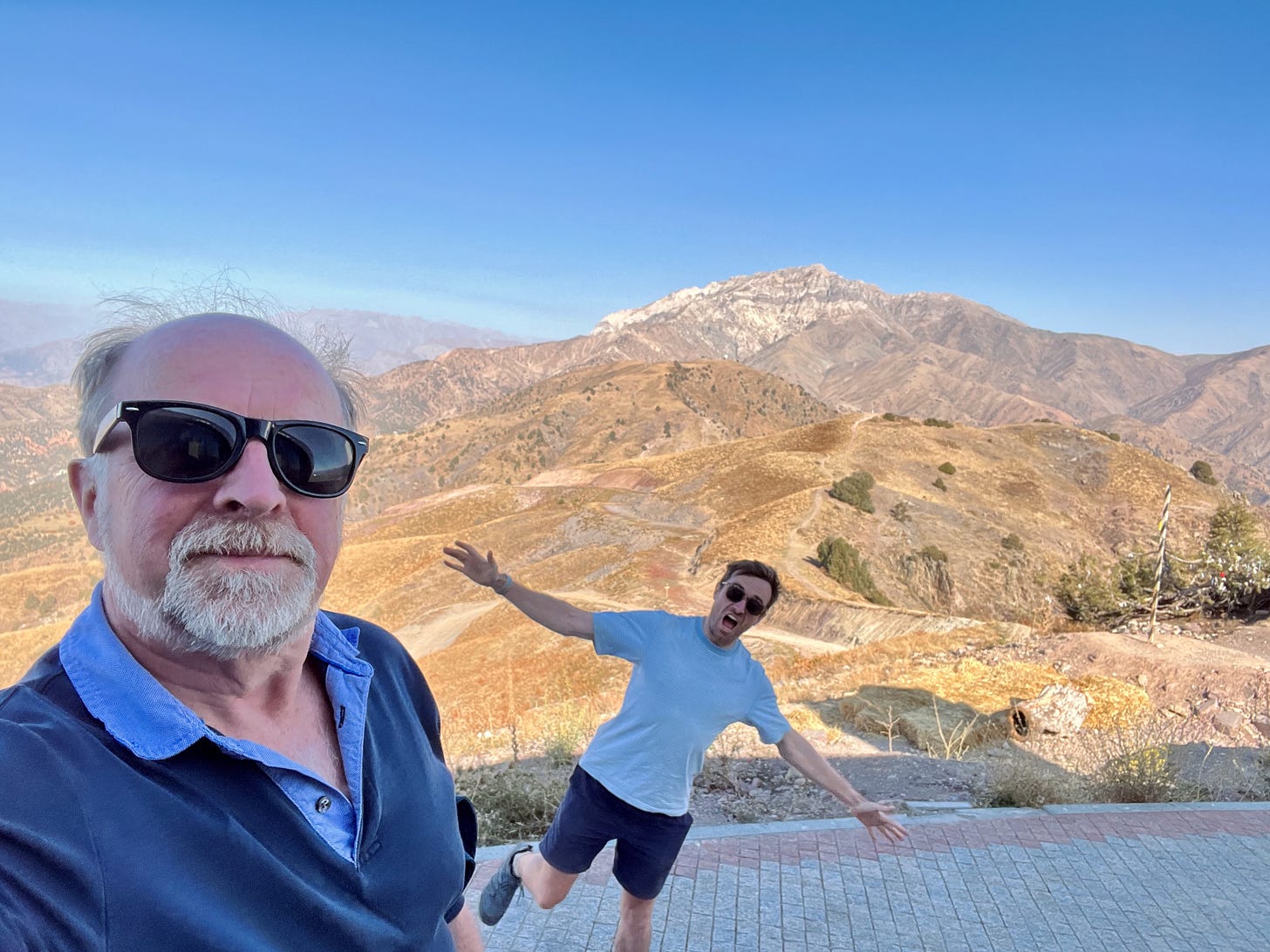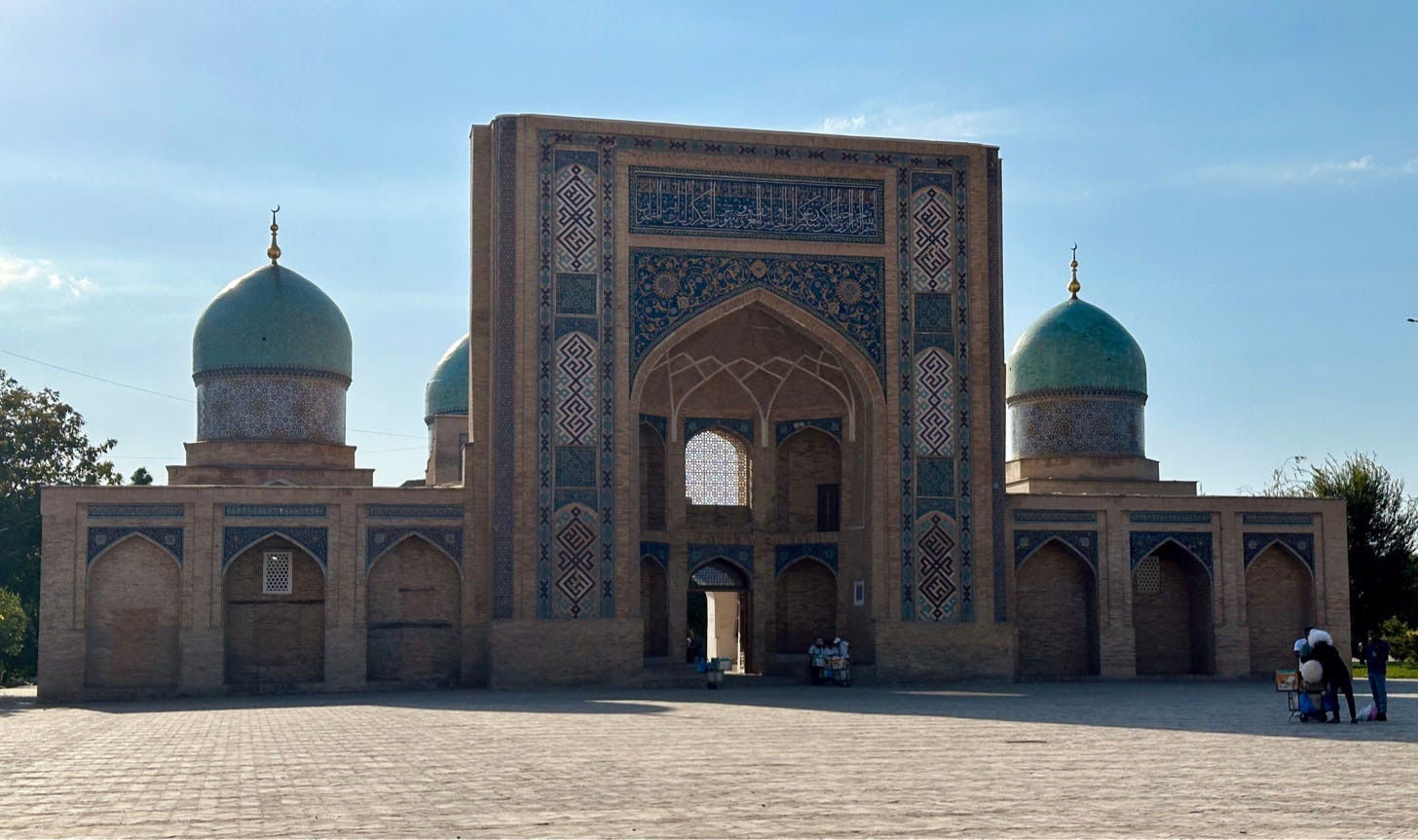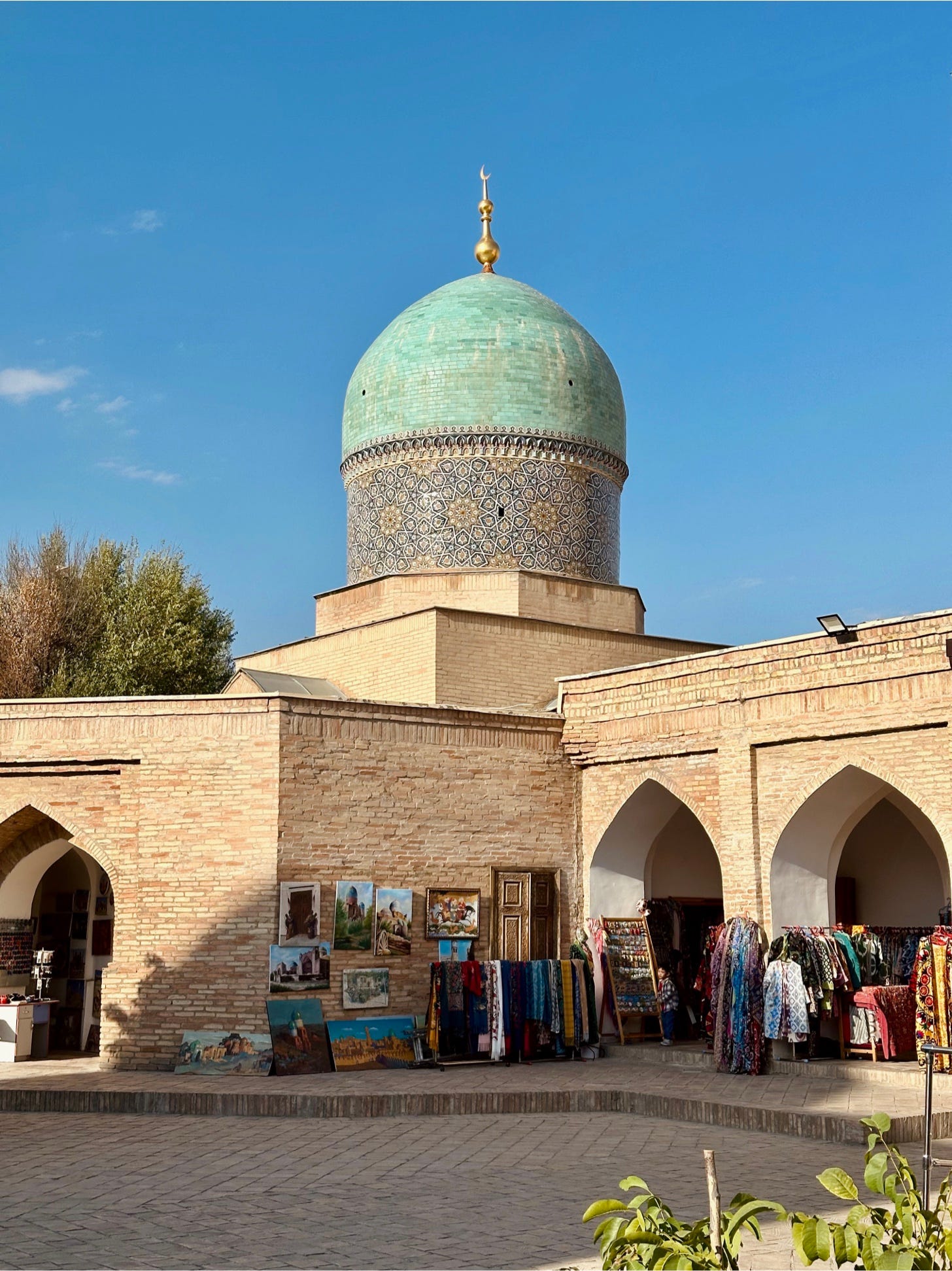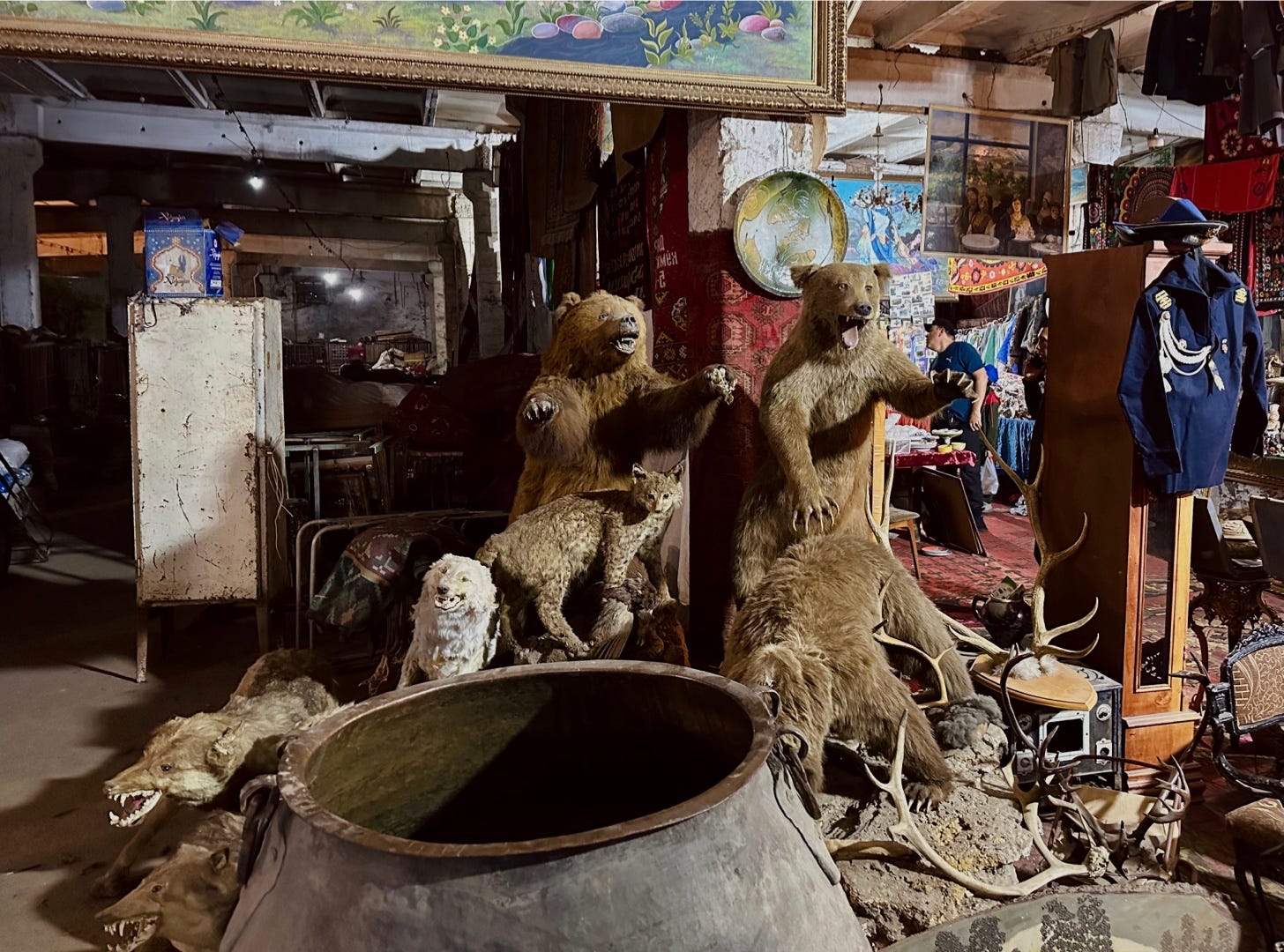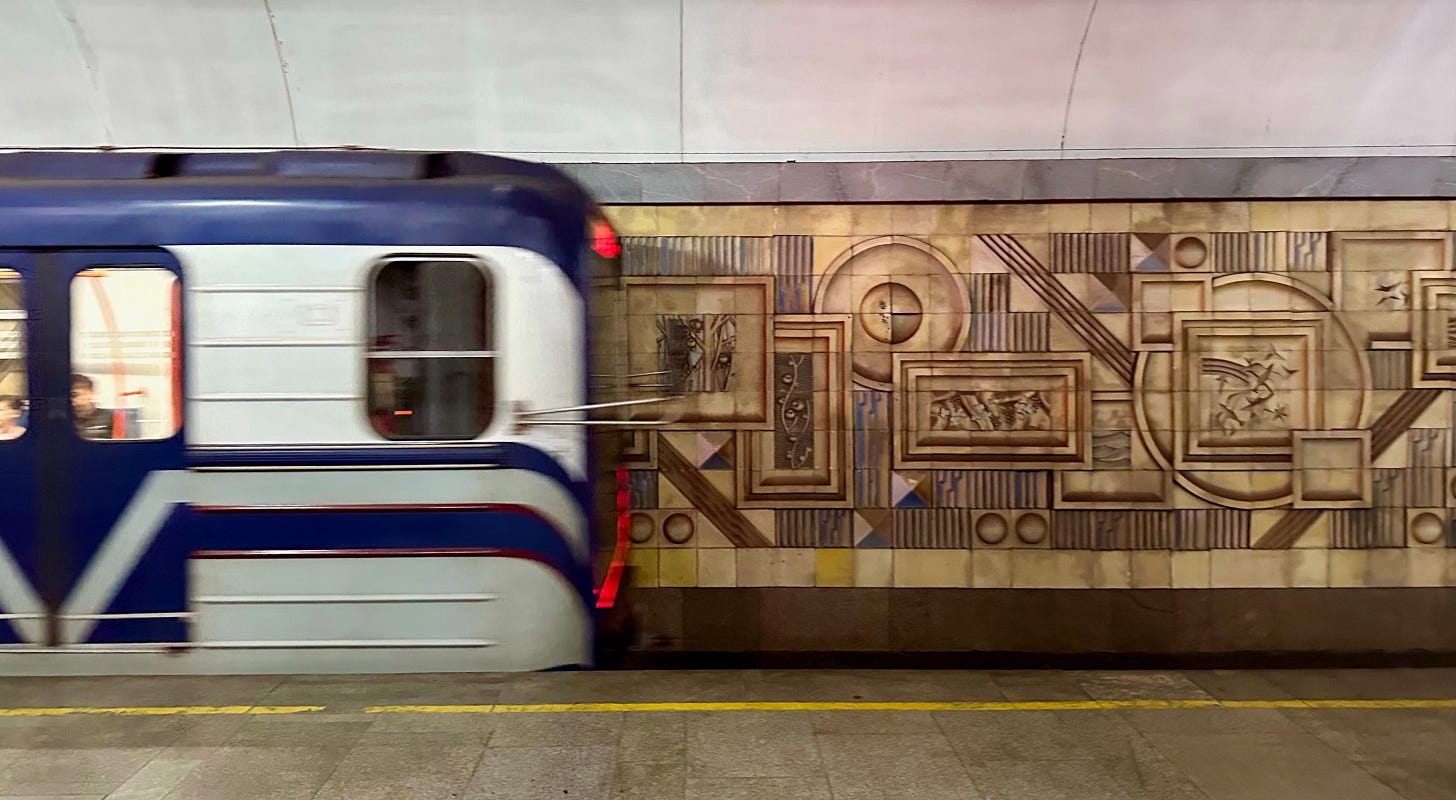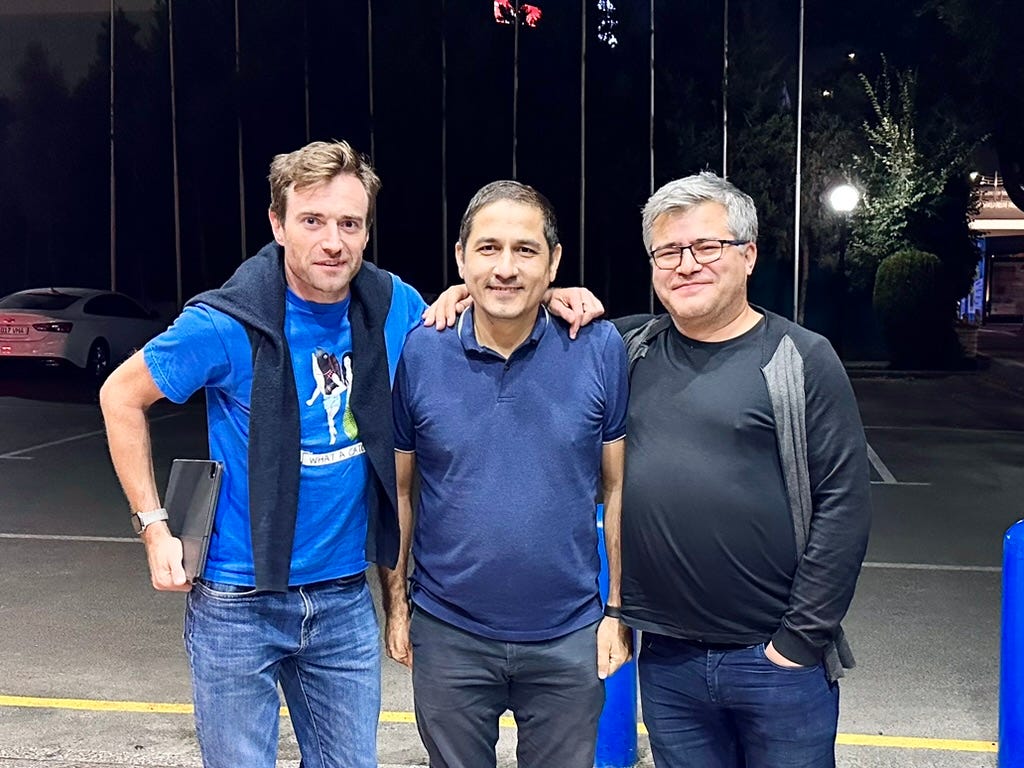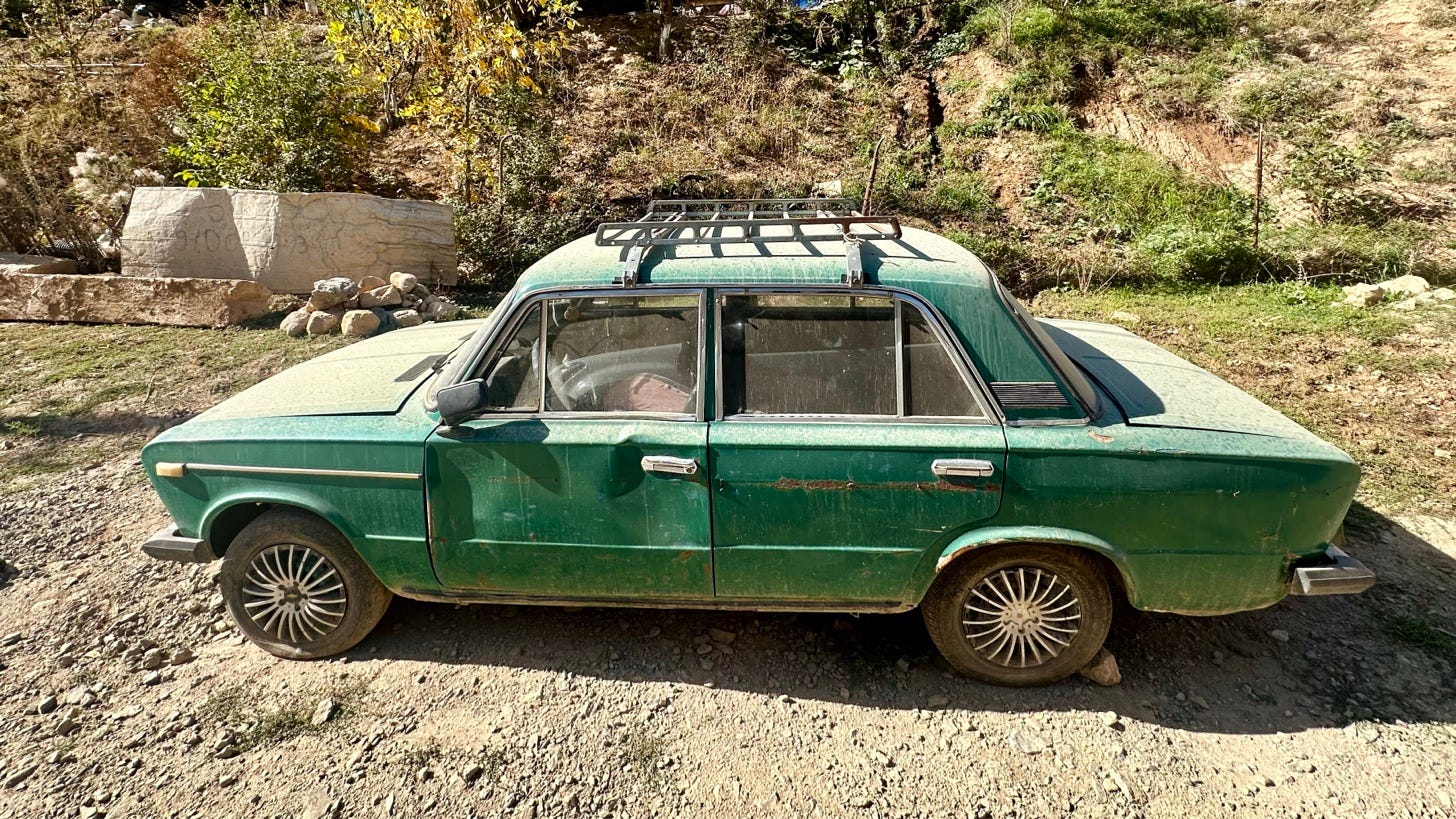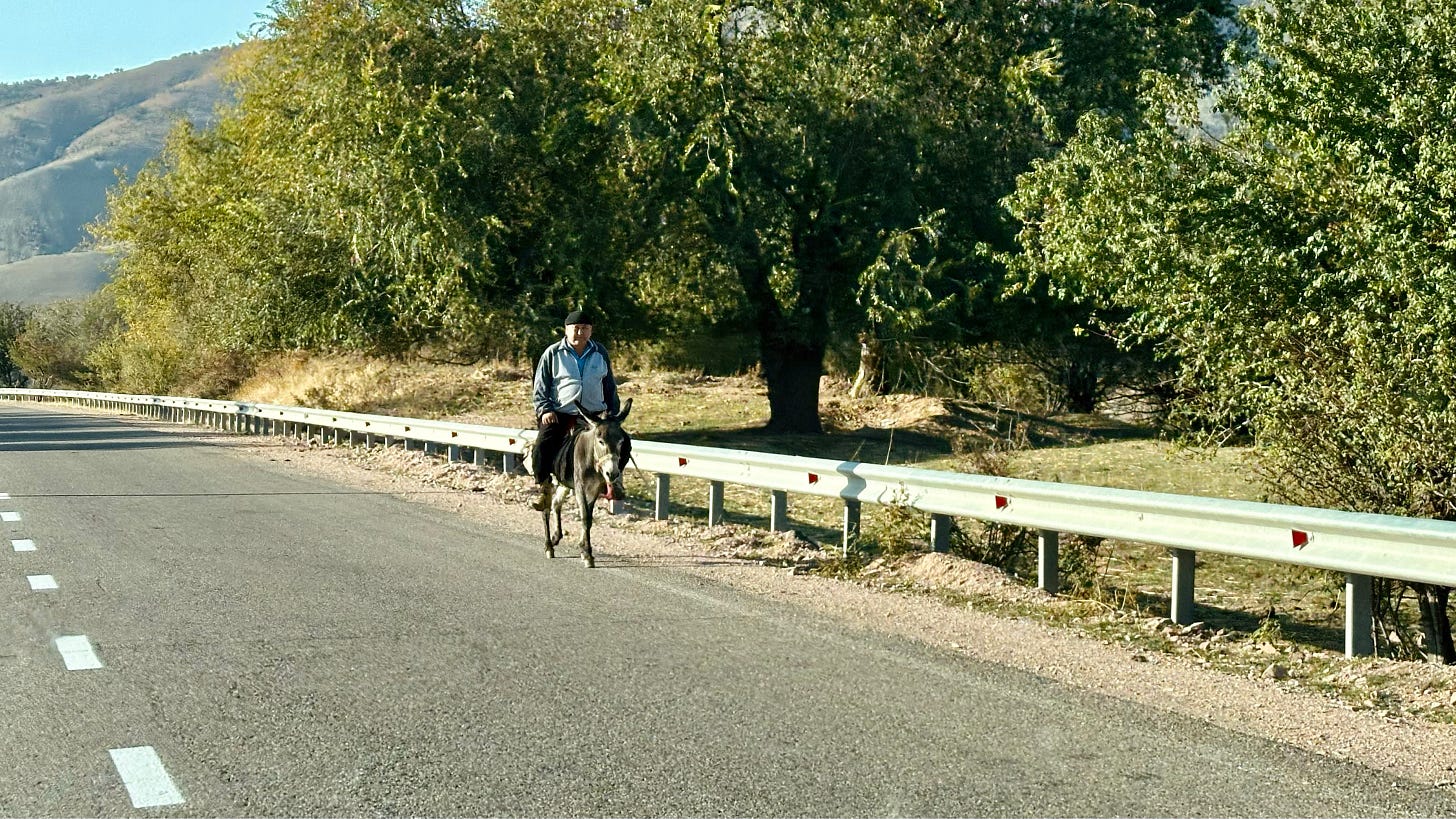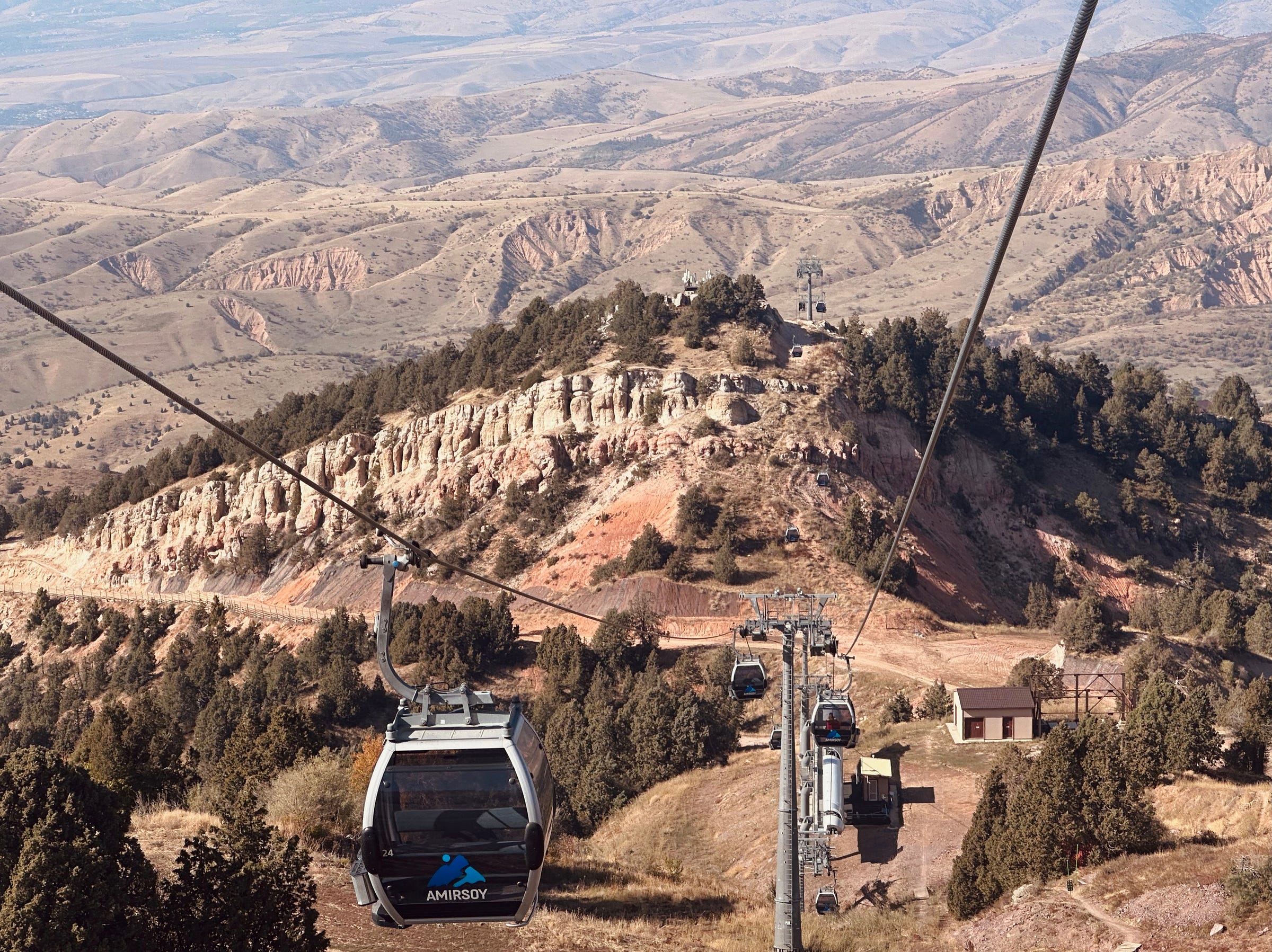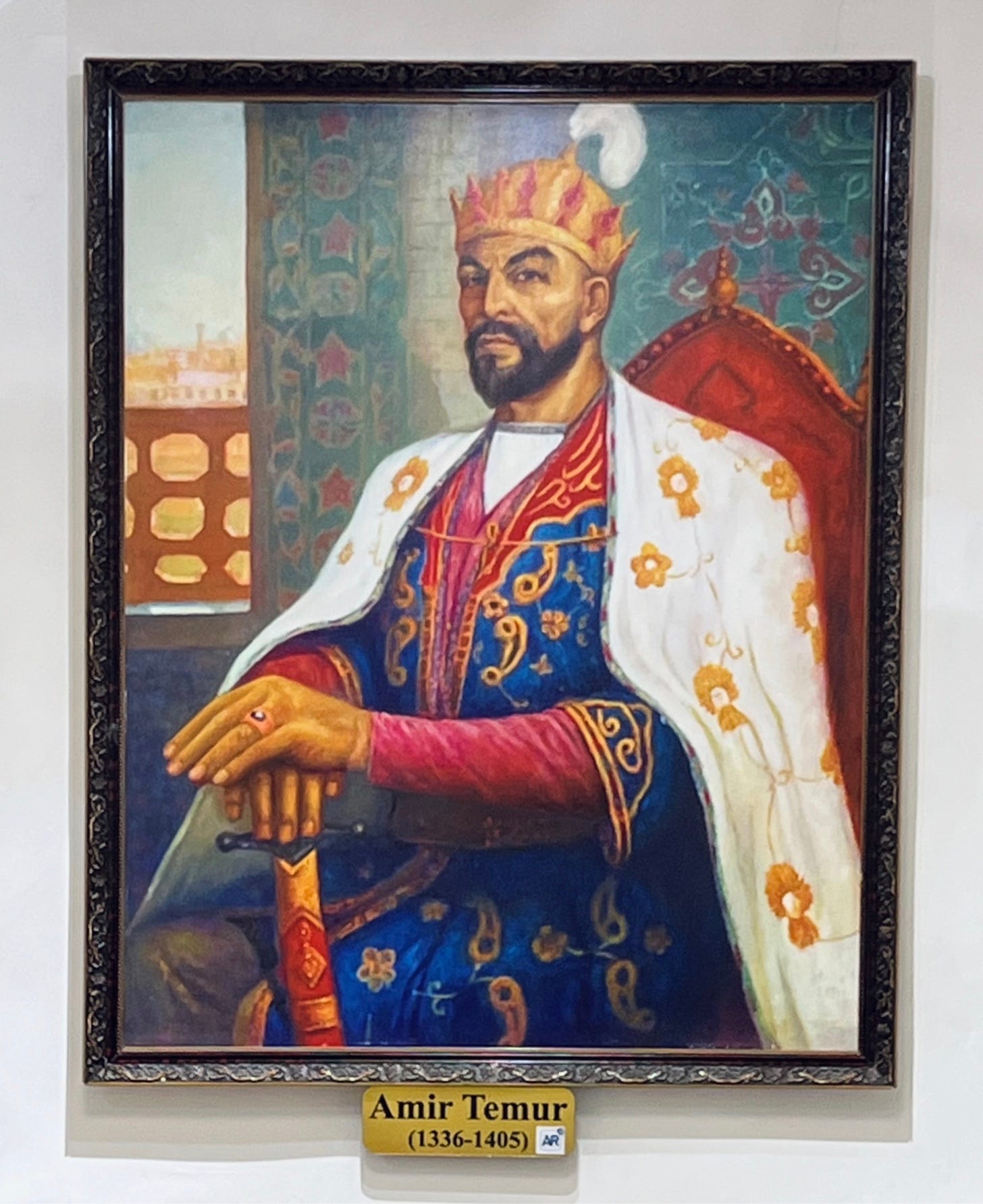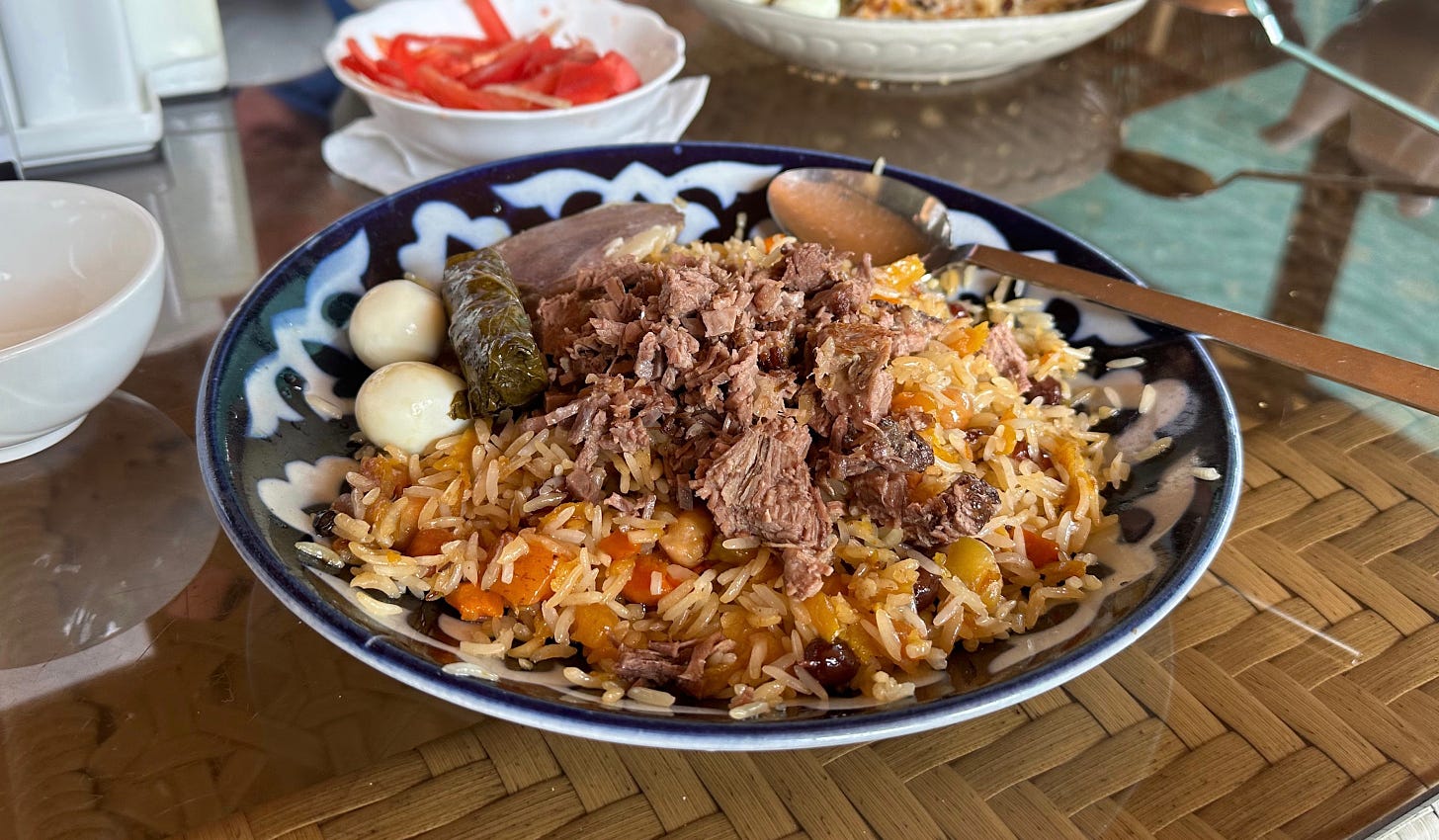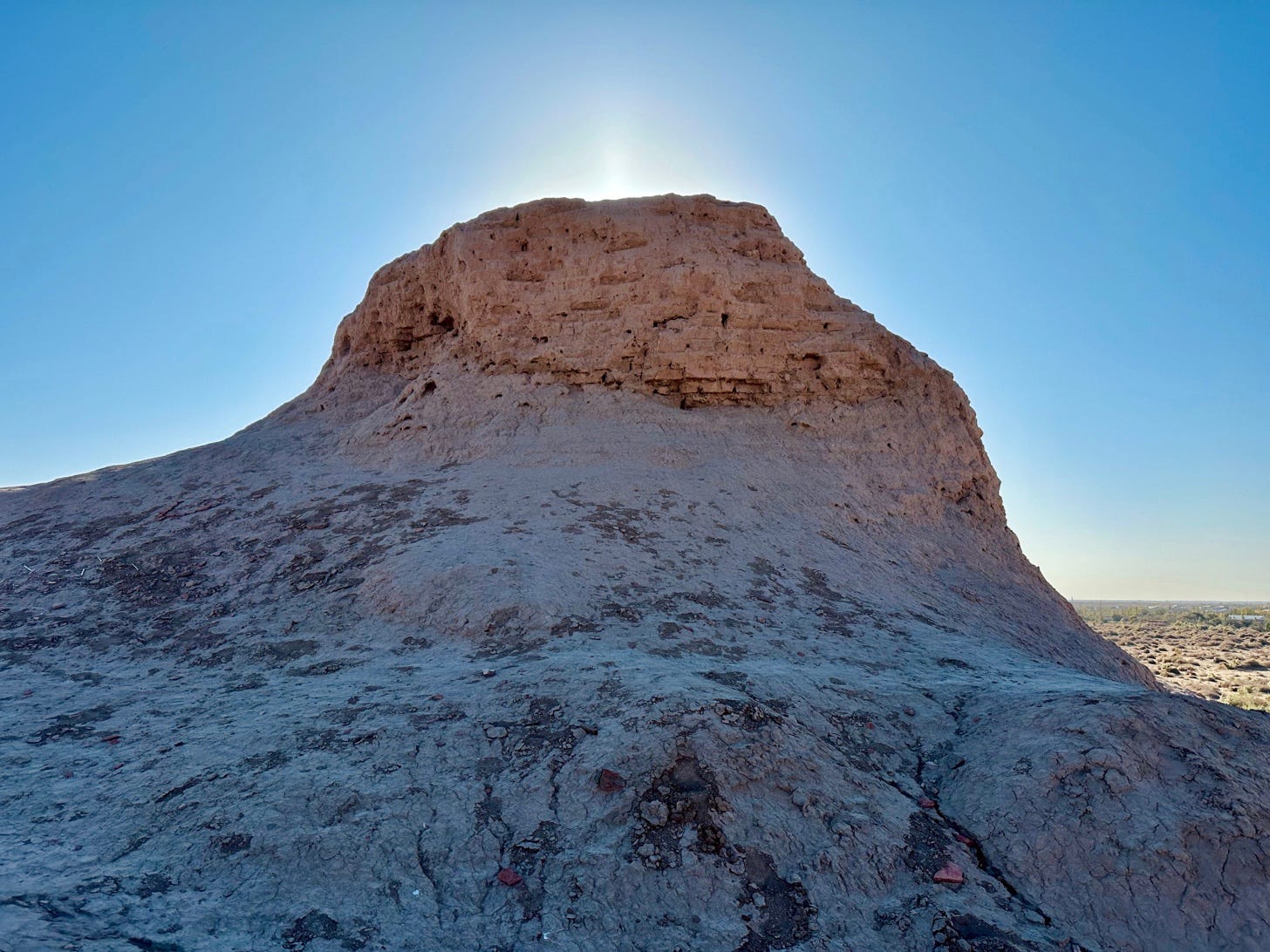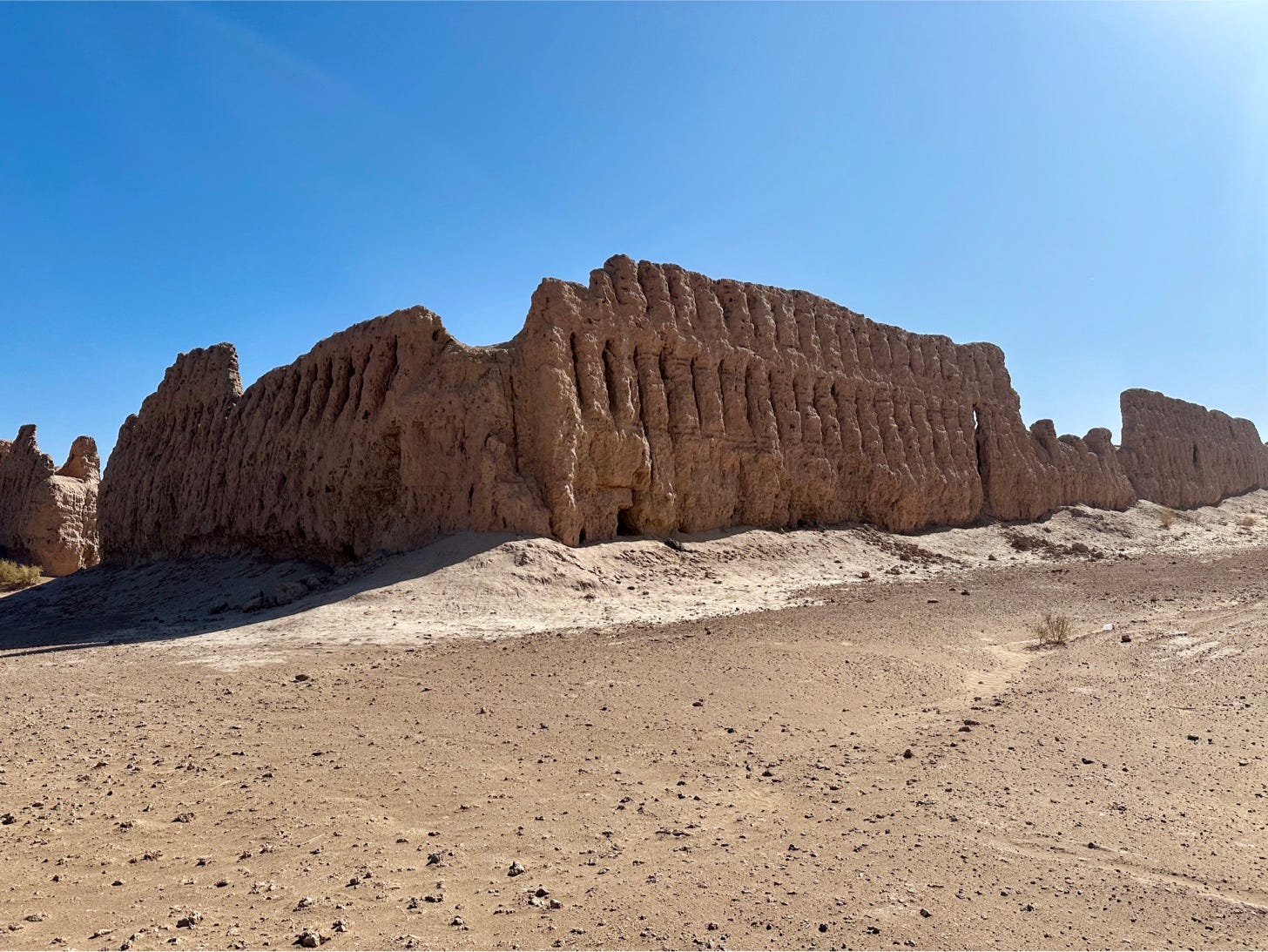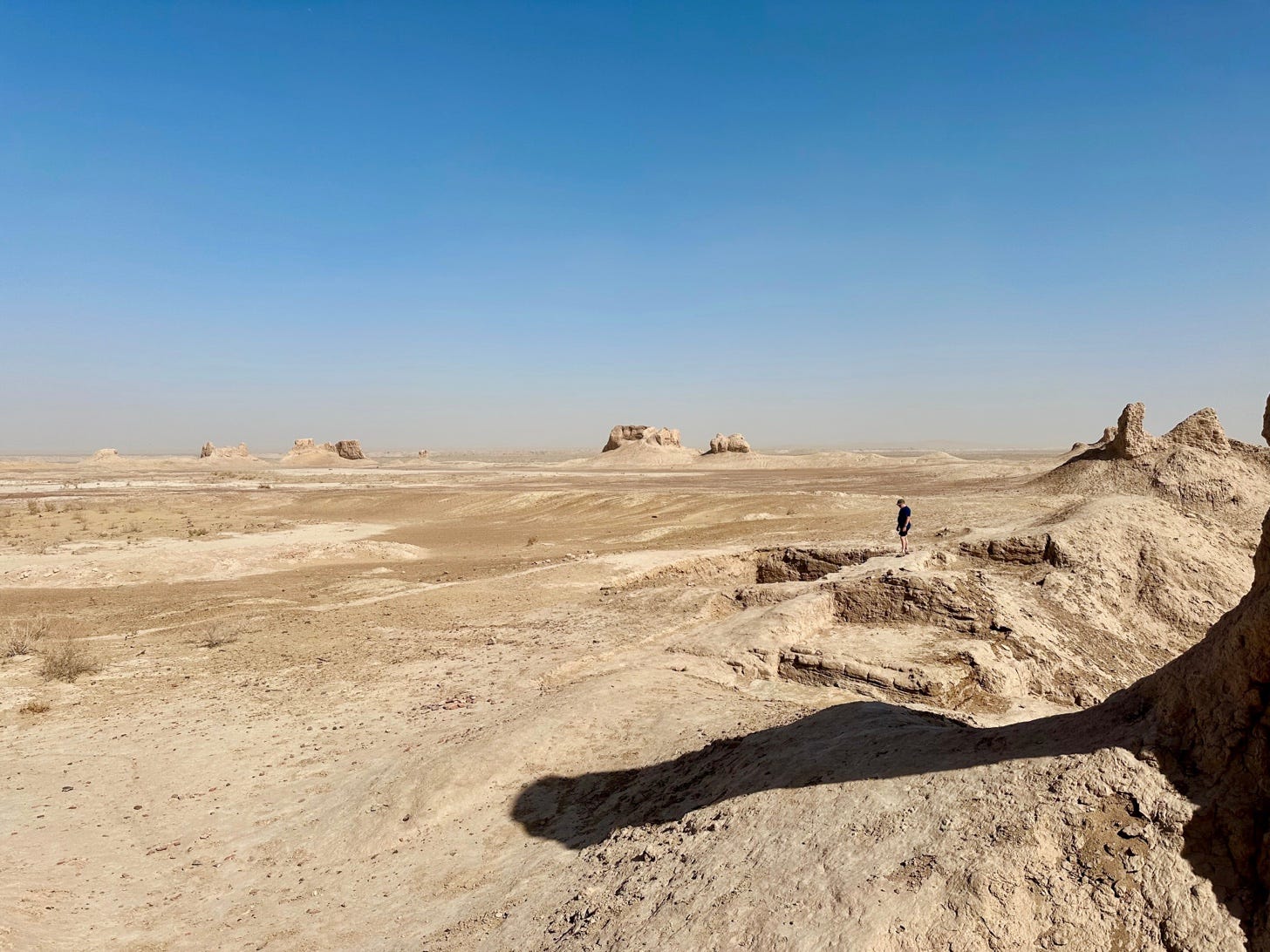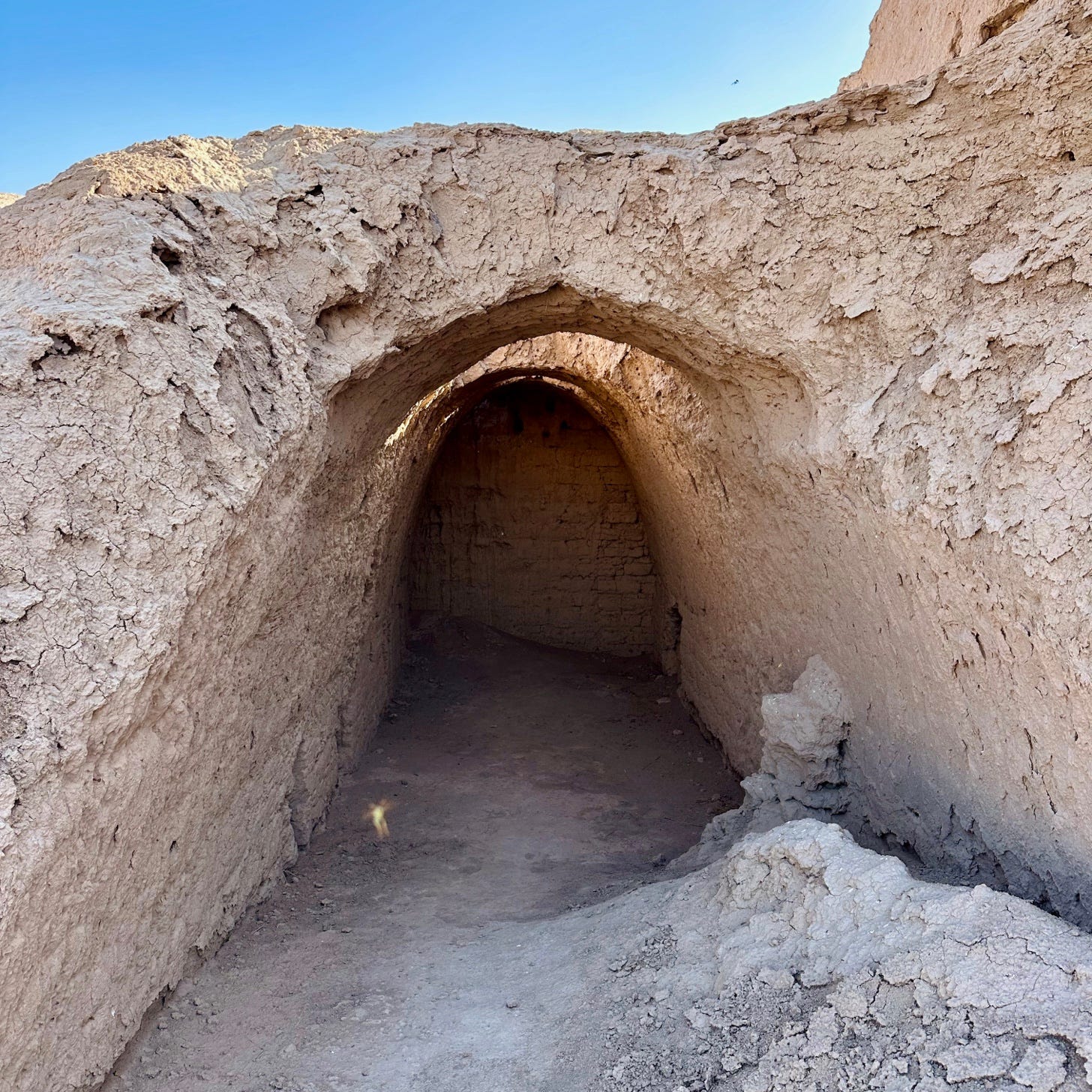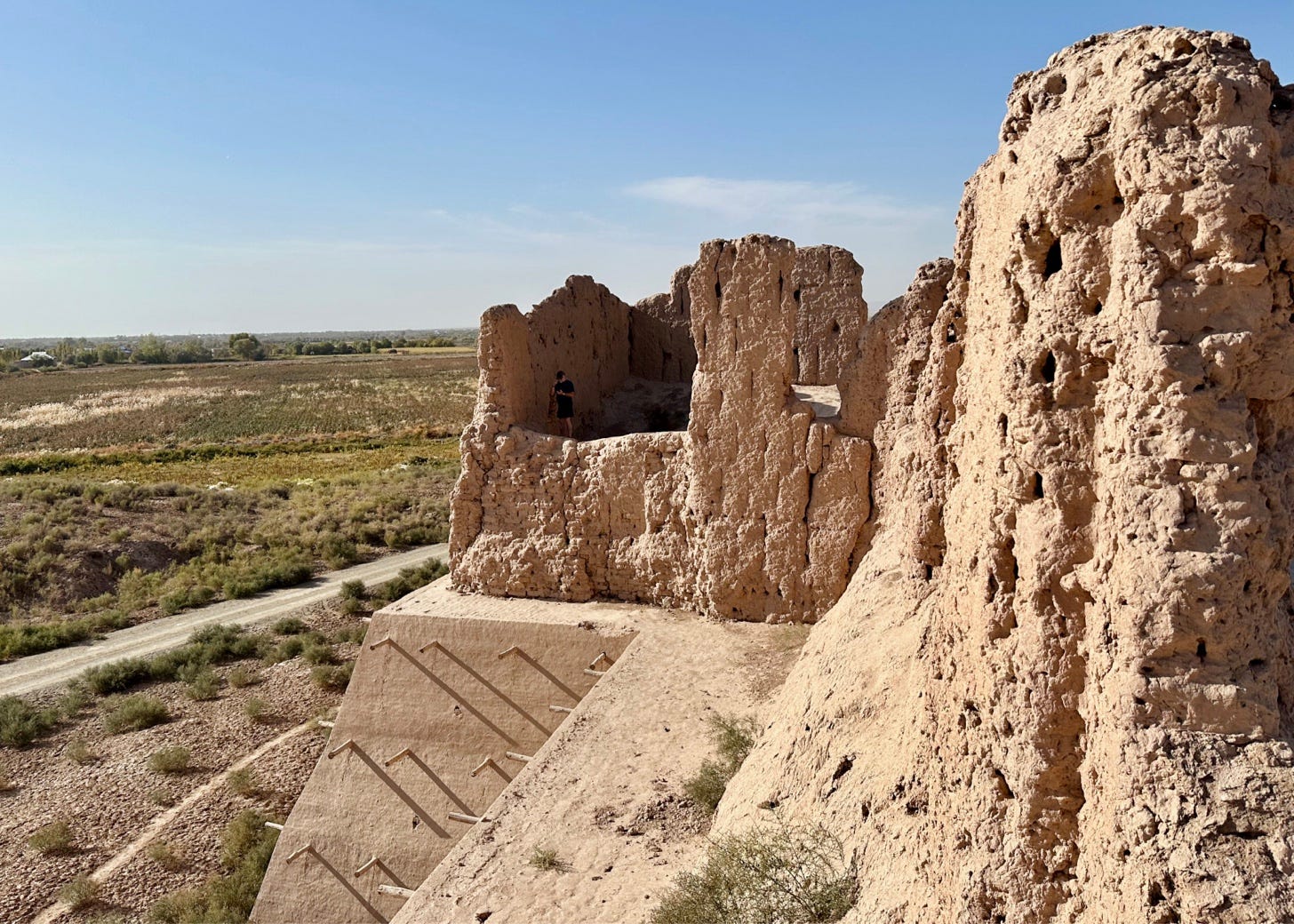A Fortnight in Uzbekistan with my Father
A trip of a lifetime to a part of the world so unique it must be seen to be believed.
My father and I just returned from a fantastic two week adventure in Uzbekistan and I felt compelled to share some highlights of our trip. This isn’t a travel blog — more a collection of random musings.
Making the best of living half a world away
Living abroad in China for 15 years I became ever more conscious of what I was missing back home. With Shanghai being 9,197km and 13hrs flight from England it was impossible for me to see my parents as regularly as my sister saw them. Limited to only a couple of big trips per year, in 2011 I decided to make the most of the limitations and try to focus on quality instead of quantity. In my early years living in China I found going home for Christmas, or even just going to our childhood home, while familiar had a tendency to feel less like a holiday for me. Christmas was such a busy time of year it could be very difficult to find time to see friends as travel within England was chaotic.
Barely a day after stepping through the door of our family home, I was back into a routine of helping with chores and, aside from taking a few days off work, my family members largely continued their normal everyday lives. Meanwhile there was still an entire world out there to be explored.
Better than I could have ever hoped
As an antidote to this, over the years I met my parents in Venice and hiked in the Dolomites in Northern Italy, ran a marathon in Tromsø in the North of Norway and hiked through Tiger Leaping Gorge near Lijiang in South West China.
After my mother passed away in late 2018, my father came to visit China for a month in late 2019 — we visited Jingdezhen, climbed Huangshan and explored Hangzhou. After Mum’s untimely passing months earlier we decided to spend Christmas together in Málaga, then met up in Prague and last summer spent a week exploring Iceland.
As soon as I made the decision in mid 2023 to leave China for good, one of my first thoughts was where we should go on our next trip. Dad turns 72 this year so I knew that we needed to make the most of our diminishing window of opportunity to go on more unusual adventures.
Why Uzbekistan?
Working in Shanghai in 2012 I had a colleague from Uzbekistan called Zafar. One day he turned to me and said, that his mother had called him to tell me she had found a bride for him and that he must go home to Uzbekistan to get married. I remember, without a moment’s hesitation, asking if I could come to his wedding, to which I received a resounding “yes”. It turned out to be one of the most incredible trips of my life and after 11 years it felt like it was time to go back and visit, but also an amazing opportunity to share this experience with my father who had long been curious about the ancient silk road that passes directly through Uzbekistan.
So the trip…
On Tue 26th Sept 2023 my father and I flew from Manchester Airport to Istanbul on the first leg of an epic two week adventure to explore Uzbekistan.
Dad is now 72 and I try to make our trips a bit more relaxing for him. In fact, who am I kidding, I am also over taking red-eye flights, spending hours transferring in airports and battling jet lag.
Istanbul was the perfect stop over on our way to Central Asia Splitting the time difference into two more manageable jumps of two hours each.
Istanbul
This post is about Uzbekistan not Istanbul, but forgive me for sharing three of the most interesting things we saw during our stopover.
Christian Mosaics in Hagia Sophia
Despite being controversially reclassified as a mosque in 2020, there are still plenty of signs of this building’s 916 years of history as an orthodox Christian church.
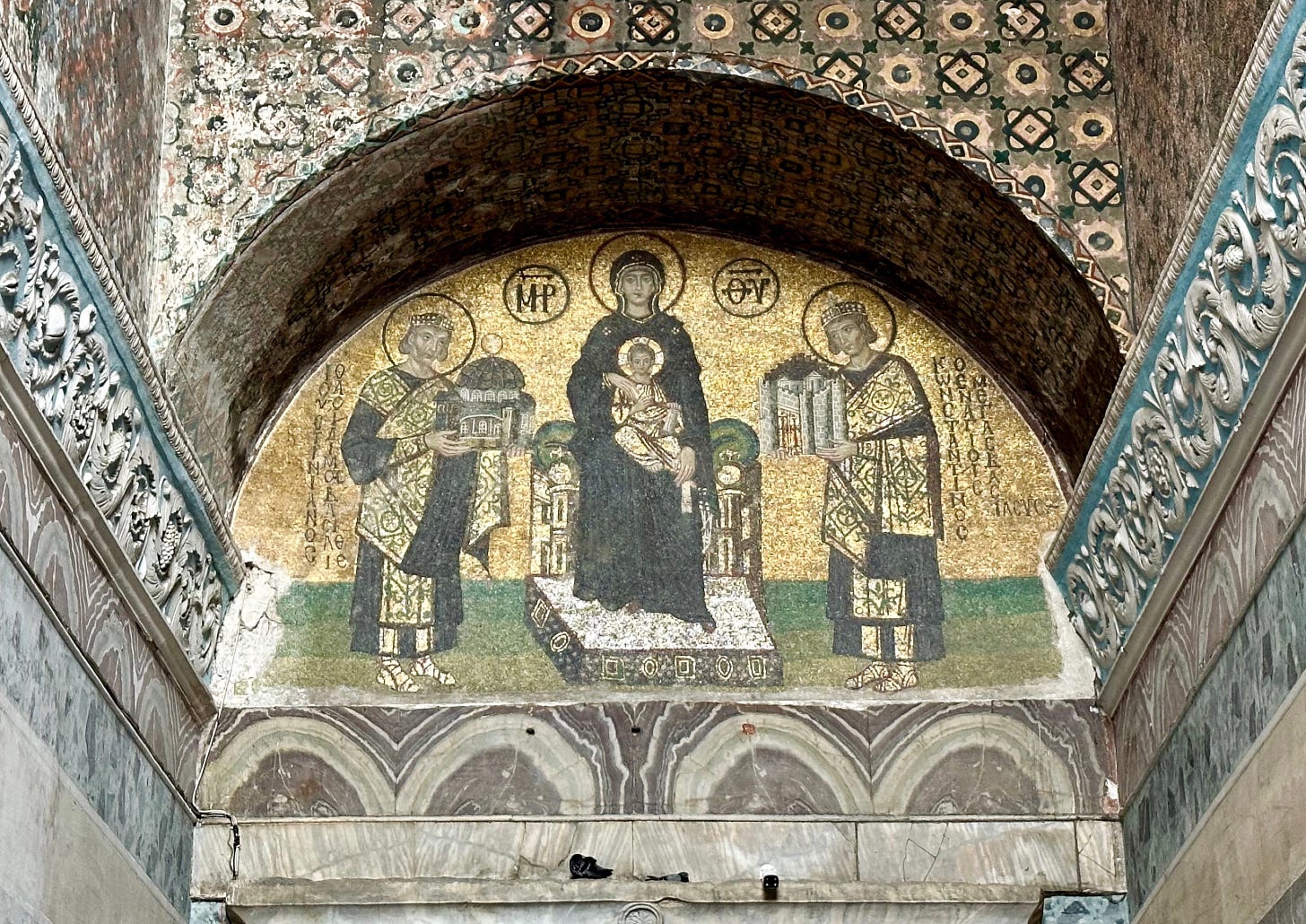
Basilica Cistern
Hidden under the streets it’s easy to miss this incredible feat of Roman/Byzantine engineering. Originally built in the 3rd century to help solve Istanbul’s shortage of drinkable water, this 9,800m² underground chamber has a ceiling supported by 336 marble columns and many other interesting features. Photographs just don’t do it justice, it really has to be seen to be believed.
Obelisk of Theodosius
As impressive as it is to look at, the story of how it came to be in Istanbul is mindblowing. Standing 19m high and estimated to weigh over 200 tonnes, this single piece of red granite was originally commissioned by Pharaoh Thutmose III in the 14th century BCE and erected near Luxor in Egypt. As the Egyptian empire declined and the Roman empire prospered the emperor Constantius II had it moved to Rome where it stood until 390 CE when emperor Theodosius I had it moved to Constantinople.
It blew my mind that over 1600 years ago this gigantic piece of granite was moved such huge distances 🤯

Ok, now the part you came for…
Touchdown in Uzbekistan
After an early flight from Istanbul, we finally landed in Tashkent the capital of Uzbekistan and were met at the airport by my friend Zafar.
The rest of this post will be about our journey across Uzbekistan.
Tashkent
Capital of Uzbekistan and with 2.4 million inhabitants is also the largest city in Central Asia. It was amazing to see how much Tashkent had changed in the 11 years since I had last visited. Signs of the country’s increasing prosperity were everywhere — dozens of new apartment buildings under construction, large advertising billboards and many more western restaurants.
We started off wandering around the city, adjusting to the time difference and getting acclimatised to the gorgeous dry sunny weather.

13,266 steps later it was time for a well deserved beer at Steam Bar, one of a host of bars that had sprung up since my last visit.
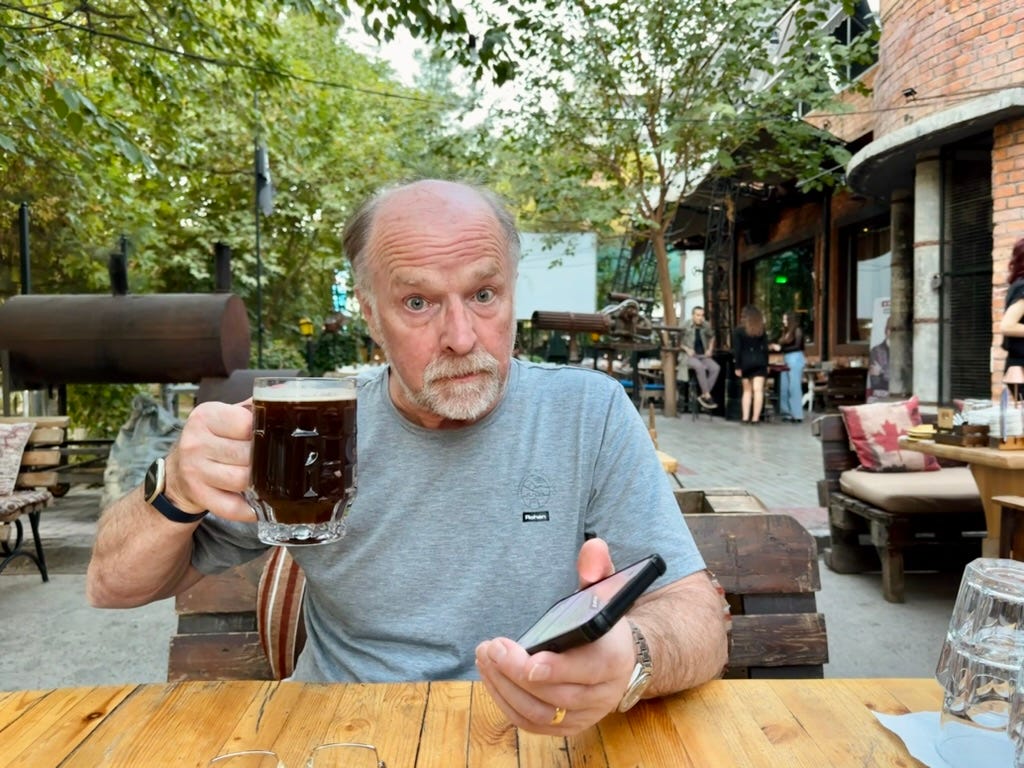
On our first night Zafar invited us for dinner at his house. A huge three story house he designed and meticulously project managed himself. With spacious rooms, high ceilings, triple glazing and underfloor heating, he has built a wonderful home for his family. It was awesome to see him, his wife, brother and four kids all doing so well.
Tashkent TV Tower
Dad and I especially like looking out across a city from the top of a tall building. So on our second day we headed to the observation deck of the Tashkent TV tower. This 375m tall broadcast mast built in 1978 and, until 1991 was the 4th tallest building on earth. As an added bonus Zafar had also never been up the tower.
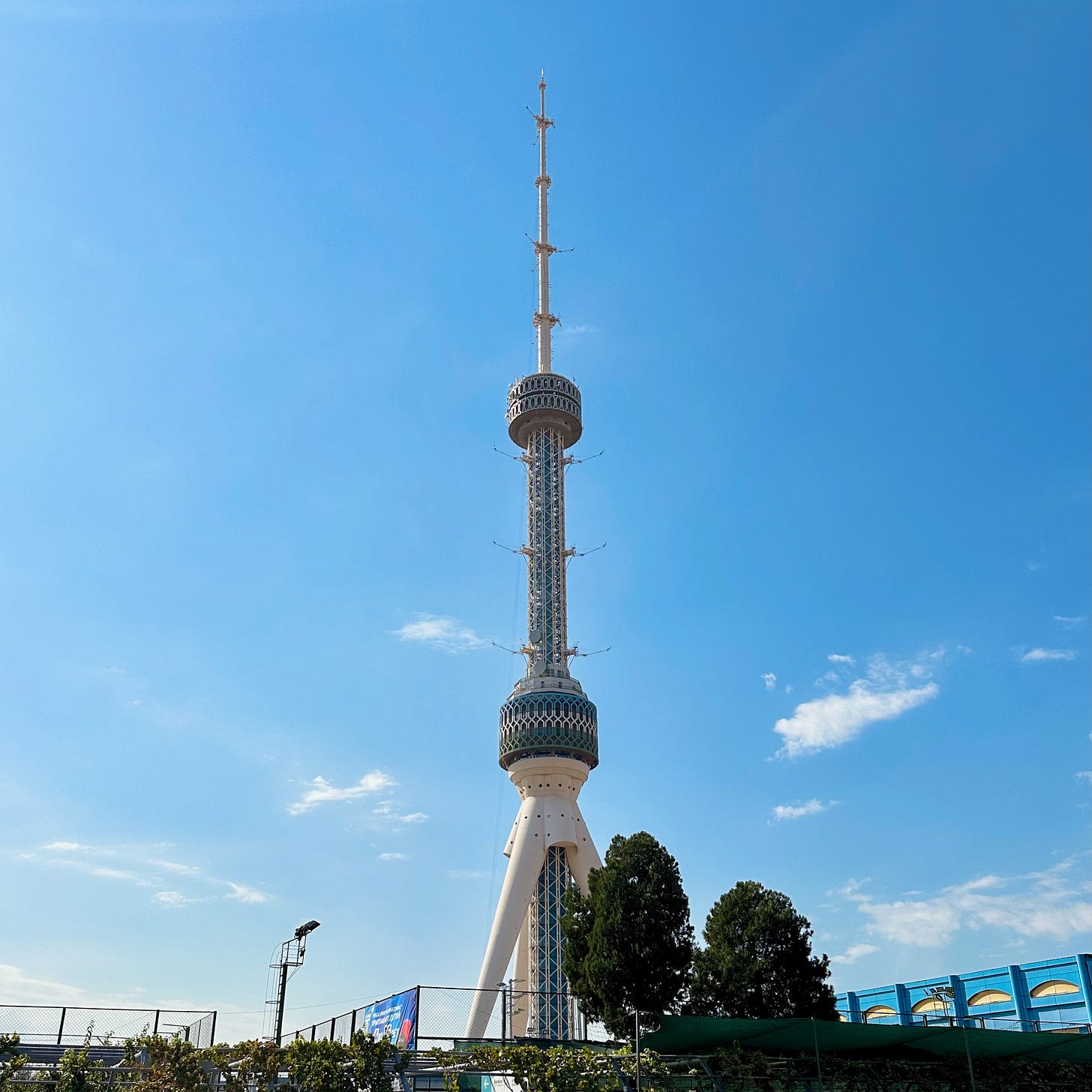
Hazrati Imam Complex
The religious heart of Tashkent where you can find the Khazrati Imam Mosque and Barak-khan Madrasah as well as the soon to be completed Center for Islamic Civilization.
Large rectangular entrances and turquoise domes are especially iconic of Islamic architecture in Uzbekistan. In fact the word ‘turquoise’ literally derives from the old French term “pierre tourques” meaning “Turkish stone”.
Quran of Uthman
However the real highlight of the Hazrati Imam Complex is the Uthman Quran. Housed in a small unassuming building in between the mosque and madrasa that belies the significance of this book.
The Quran of Uthman is one of, if not the original copy of the Quran. Commissioned by the third caliph Uthman just 19 years after the death of the prophet Muhammad. Although undeniably very old, there are debates about the exact heritage of this Quran. According to the description in the museum it’s written on deer skin and even has blood stains from Uthman himself because he was murdered whilst reading it.
Having been raised in the Christian faith where everything seems so intangible it was incredible to see such a significant historical religious text.
Chorsu Bazaar
No trip to Tashkent would be complete without a visit to the Chorsu Bazaar. Aside from its impressive dome it’s fun to wander around and see the local produce on sale.


Yangibod Bazaar/Flea Market
Slightly more off the tourist trail, on Sunday we headed to the Yangibod weekend flea market. You name it, and you can probably find it somewhere in Yangibod’s endless sprawling alleyways.
I don’t think Dad was quite as charmed by it as I was and upon hearing we’d visited the Yangibod flea market Zafar proclaimed “how the hell did you find that place, I’ve only ever been there once”.
Sacred Heart of Jesus Cathedral
On our way back towards the center of the city we visited Tashkent’s Catholic cathedral. Despite having a predominantly Muslim population, Uzbekistan is a secular society and in recent years has allowed increasing freedom of religion.

Glorious architecture of the Tashkent Metro Stations
It might seem strange that TripAdvisor ranks Tashkent’s metro as the #1 ‘Thing to Do’ in the city — however this is entirely justified. Built in 1977 it is a triumph of soviet architecture with each station designed around a different theme.
Last time I was in Tashkent in 2012, I was arrested for surreptitiously trying to take a photo of one of the stations. I was hauled off to a small windowless interrogation room in one of the stations and made to go through and delete all of the photos of the metro on my camera.
Supposedly this ban on photos was down to Tashkent’s metro stations being designated military sites and nuclear bomb shelters! However we were told that to deliver on President Shavkat Mirziyoyev’s plan to attract more tourists to Uzbekistan, the government conducted a survey of visitors and the #1 request was to be allowed to take photos on the metro.

Shooting the breeze with old pals
On the 3rd night I had drinks and dinner with Zafar and Sherzod. The years of not seeing each other instantly disappeared and until nearly midnight we chatted about anything and everything. Both of them have a computer science background and work in technology roles so we had plenty to talk about, not least their disappointment at me being almost 40 and still unmarried 😆
Undoubtedly my favourite thing about having lived abroad for the past 15 years is the wide diaspora of people I’ve met and made friends with — my life feels immeasurably richer for it and it gives me great pleasure to share this side of my life with my Dad.
Chimgan Mountain
Both Dad and I being huge fans of the great outdoors and especially mountains. I decided we should hire a car and drive north west out of Tashkent towards the Ugam-Chatkal national park.
Feeling uninspired by the selection of Chevrolets we decided to hire something a bit more adventurous – so we went for a gigantic Isuzu D-Max 4x4 pickup truck. The proprietor of the car hire office reassured us the roads were fine out near Chimgan, but little did he know that its off road capabilities would prove essential.
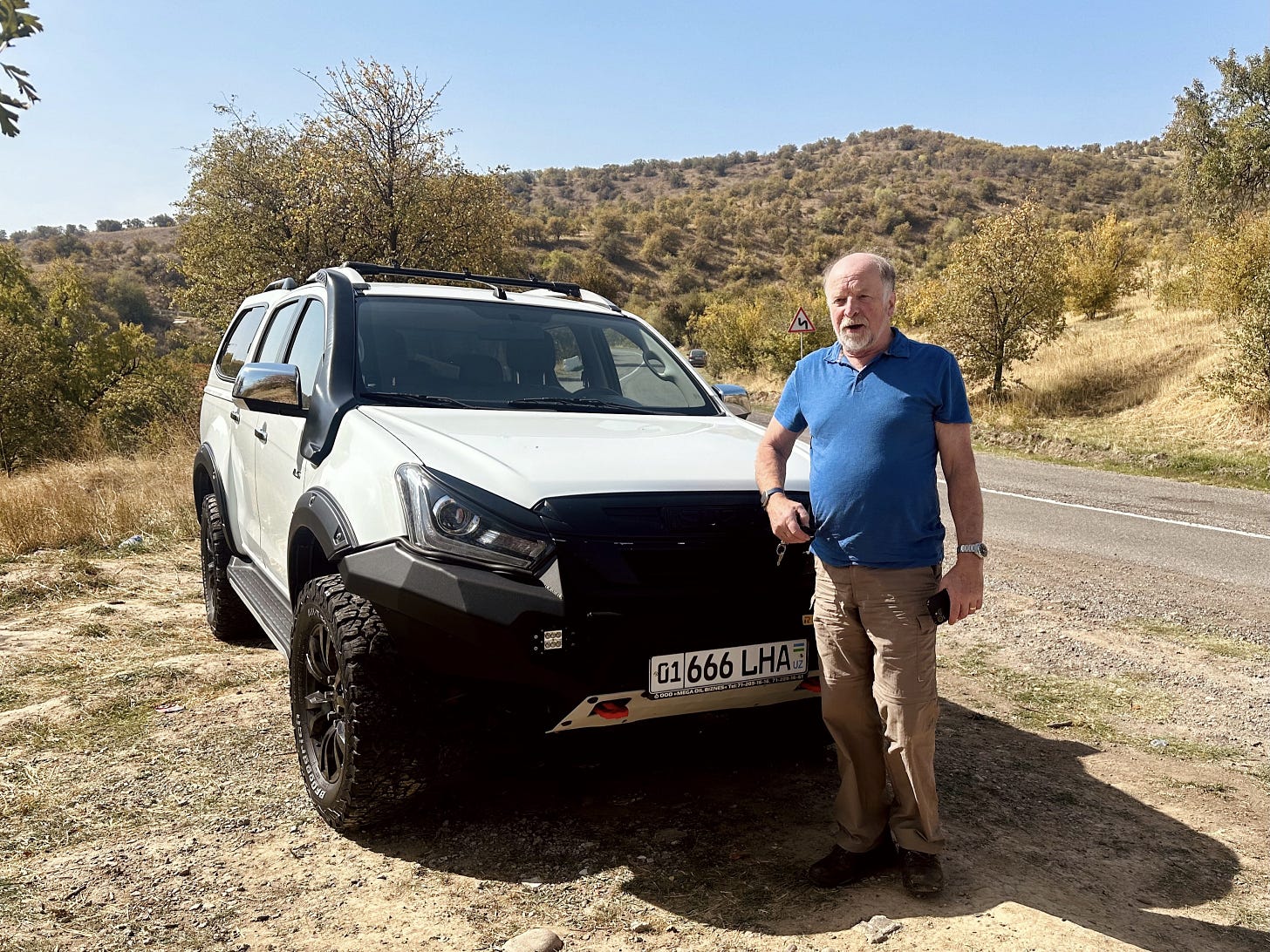
Our first stop was the Charvak Reservoir, 80 kilometers to the North East of Tashkent. Completed in 1970 this 168m tall stone dam holds back a 40km² reservoir containing two cubic kilometers of water. This water is used to drive 4 huge 150 megawatt turbines at the Charvak Hydropower Station, providing electricity for a few hundred thousand residents of the Chirchiq valley.
Gulkam Gorge
On our second day in the mountains we drove off the main road and made use of the off road abilities of our hired monster truck.
When the road was no longer driveable we hopped out and continued on foot. It was amazing to see the rock strata misshapen and twisted by the immense force of the Indian subcontinent crashing into the Eurasian tectonic plate roughly 50 million years ago.
Our hike in the hot sun was rewarded with spectacular views of the gorge.
Getting Around
Away from Tashkent we saw a lot more old Ladas and Dad was very taken by the old Soviet made UAZ-469 light off road vehicles.
Not just Soviet era vehicles, but away from the city we also saw many more people relying on donkeys as transport.
Amirsoy Ski Resort
On our way back to Tashkent we stumbled across Amirsoy a new €100m ski resort. Opened in 2019 this impressive facility is a sign of Uzbekistan’s increasing prosperity. We took the beautifully smooth and quiet Swiss made cable cars up to the very top (2290m) and were rewarded with incredible views across the dry landscape.
After two days in the mountains it was time to drive back to Tashkent.
Hotel Uzbekistan
Back to Tashkent I had decided it was time for Dad to say goodbye to western comfort and experience the soviet glory of the Hotel Uzbekistan. This grand brutalist monolith standing in the center of Tashkent has barely changed since it was built in 1974, back when Uzbekistan was still part of the USSR.
Our spacious room was exactly as basic as I remembered from my previous trip and even included UK style rectangular pin plug sockets.
Amir Timur
After gaining independence from the USSR in 1991, Uzbekistan tried to establish a new stronger sense of national identity. Amir Timur, one of history’s greatest conquerors was the perfect national hero. Aside from being an undefeated commander, he was also a polyglot and patron of the arts and sciences. His empire stretched from Mongolia to Turkey and he made Samarkand in modern day Uzbekistan the capital of his empire.
Amir Timur Museum
Wanting to learn more about this great figure we decided to check out the museum dedicated to him. One review on TripAdvisor warned that there wasn’t much information in English and hiring a guide would help us get more out of our visit. I’m immensely glad we followed this advice. Our guide spoke perfect English and was brimming with pride and enthusiasm for his country. During out 90 minute tour we didn’t make our way around a huge amount of the museum, but peppered our guide with questions and learned an incredible amount about the fascinating history of Uzbekistan.
Aside from learning about the many triumphs of Amir Timur, we also started to get a better understanding of the immense contributions made by key figures in Central Asian & Islamic history. One particular highlight was learning about the 9th century mathematician Muhammad ibn Musa al-Khwarizmi often referred to as the ‘father of algebra’ and whose name later become the word ‘algorithm’. We also learned about Avicenna the ‘founder of early modern medicine’ whose books The Book of Healing and The Canon of Medicine were the standard medical texts for over 600 years after he died.
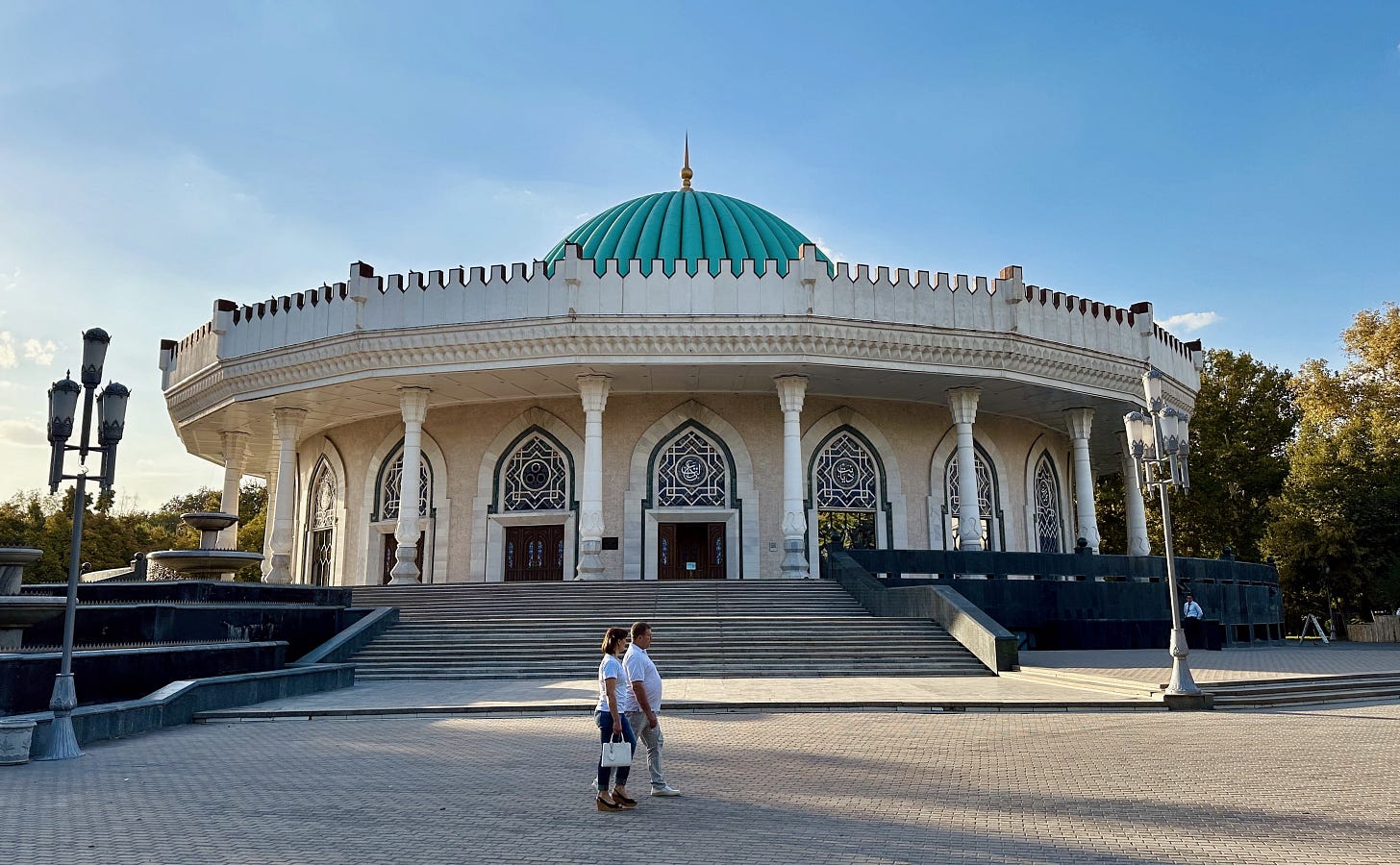

Plov at Last
Plov, plof, pilaf — call it what you will it’s delicious and I’m amazed we spent 5 days in Uzbekistan before trying their famous national dish.
What better place to eat Plov than at the Besh Qozon Plov kitchen in Tashkent.
Our time in Tashkent was over and so we said goodbye to Zafar and hopped on a train to…
Samarkand
Our journey along the silk road had begun. We started by visiting Registan, the ancient public square where people would have gathered to hear royal proclamations and witness executions. It’s surrounded on three sides by impressive madrasas, the most famous of which is that of the Sultan and Astronomer Ulugh Beg, on the west side of the square.
It was around this point in our journey that both Dad and I fell foul of Islamic decorum. I attempted to enter the Shah-i-Zinda Mausoleum Complex wearing shorts and later in Bukhara Dad was similarly reprimanded when entering the Kalan Mosque. Each time we were made to wear a skirt before we were allowed to enter.
The skirts were a small price to pay to witness amazing sights like the ornate ceiling of the Tilya Kori Madrasa.
We only had a day in Samarkand before we made the 4 hr drive to Bukhara. I let Dad sit in the front hoping it would make the long drive more comfortable for him, but staring at the chaotic driving habits of the Uzbek road users seemed to make him more anxious.
Bukhara
Similar to Samarkand, there was too much to see in Bukhara for me to do it justice here and in hindsight we could easily have spent another day there.
Learning from our guide that Tajik was the most commonly spoken language in both Samarkand and Bukhara began to give us a sense of the complexity of the post Soviet -stan countries.
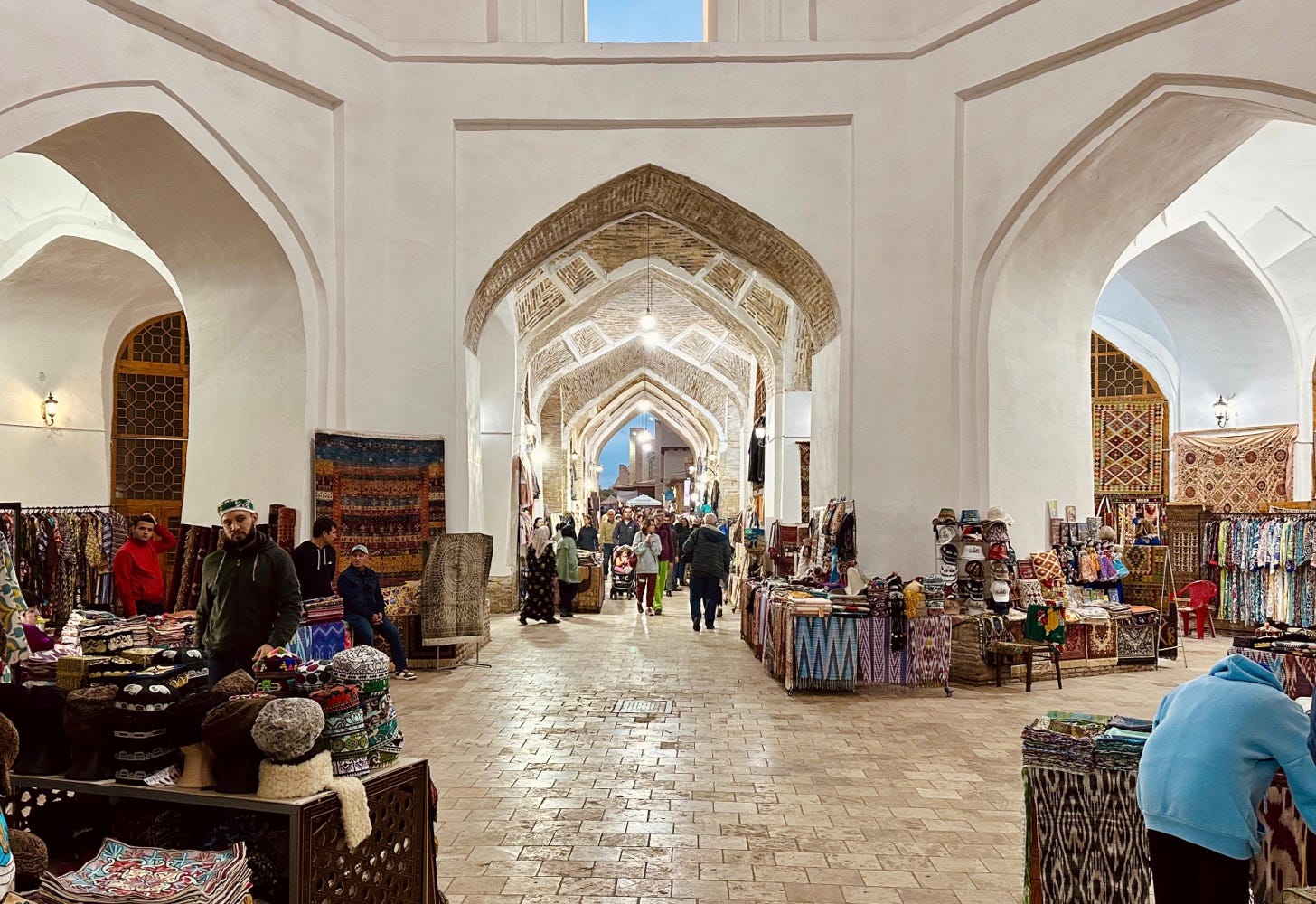
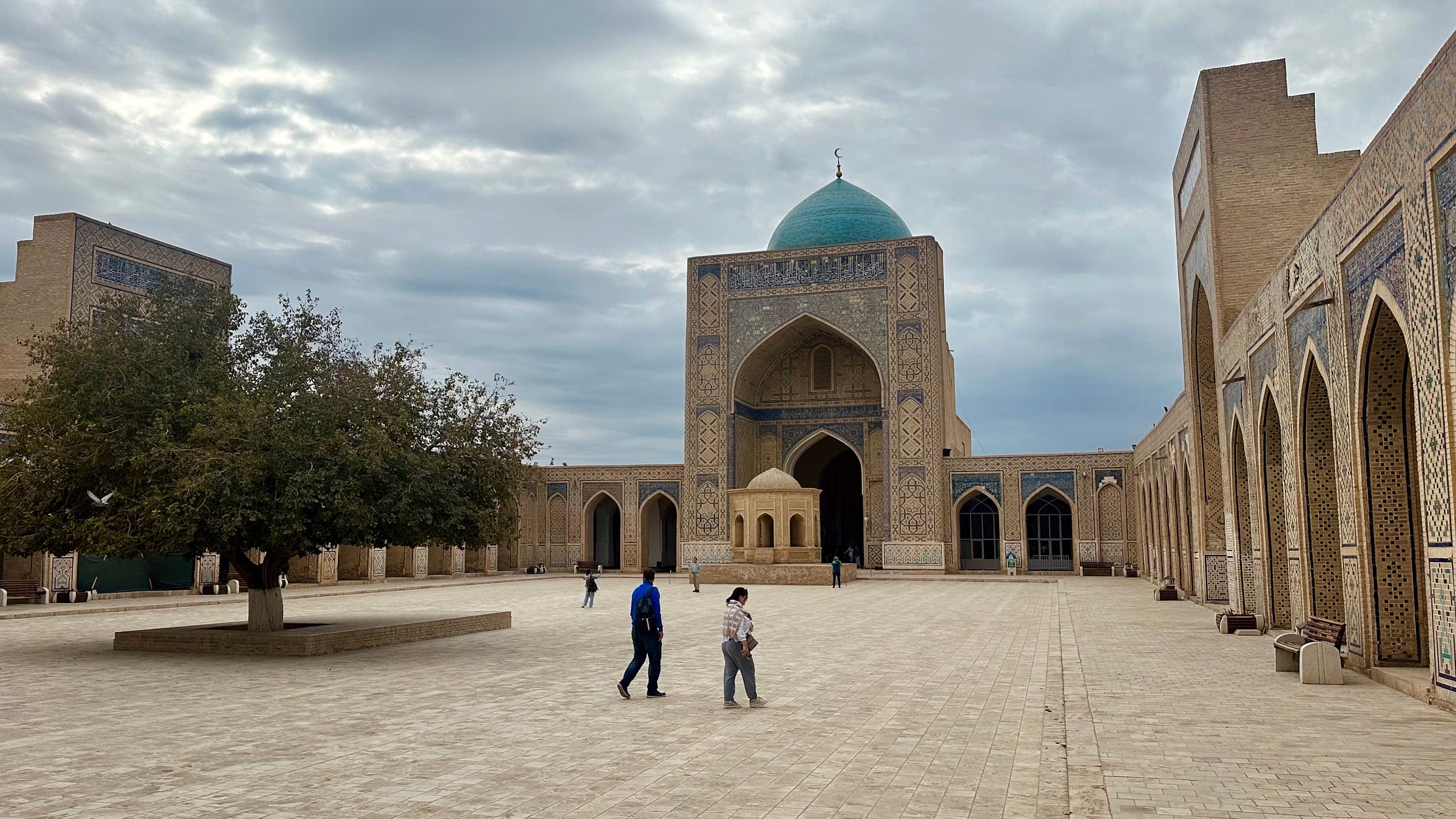
Train to Khiva
After the long and not especially relaxing car journey from Samarkand to Bukhara we decided to take the overnight sleeper train to Khiva. Our tickets cost an outrageous price of 155,000 SOM (US$13) each. Despite the aging Soviet train carriages, it turned out to be one of the best night’s sleep I had during our entire trip.
Khiva really is a special place. A tiny walled city and important trading post on the ancient Silk Road between Europe and the Far East.

Traditional wedding day celebrations in Khiva.
Last and almost definitely not least…
The Khorzem Fortresses
With an extra day in Khiva we decided to get out into the desert. Inspired by a blog post we decided to go on a private tour of the ancient Khorzem fortresses.
It seems crazy that they’re still on UNESCO’s tentative list because these gigantic structures made of mud and straw date back as far as the 4th century BCE. There are estimated to be over 50 of them although only a handful remain in a discernible condition.
Khorzem became an independent state sometime after the 4th century and the fortresses were built to protect the people living in the fertile lands of the Khwarazm oasis. Over the centuries they defended against multiple attacks, but ultimately could not resist Genghis Khan.

It’s hard to get a sense of just how enormous some of these fortresses are — I tried as often as possible to ensure Dad was in shot to give an idea of scale.
Dumon Kala
Guldursun Kala
Janbas Kala
Kirkkiz Kala
Similar to the other fortresses the ground is covered with fragments of ancient pottery, surely many lifetimes of work for archeologists.
Ayaz Kala

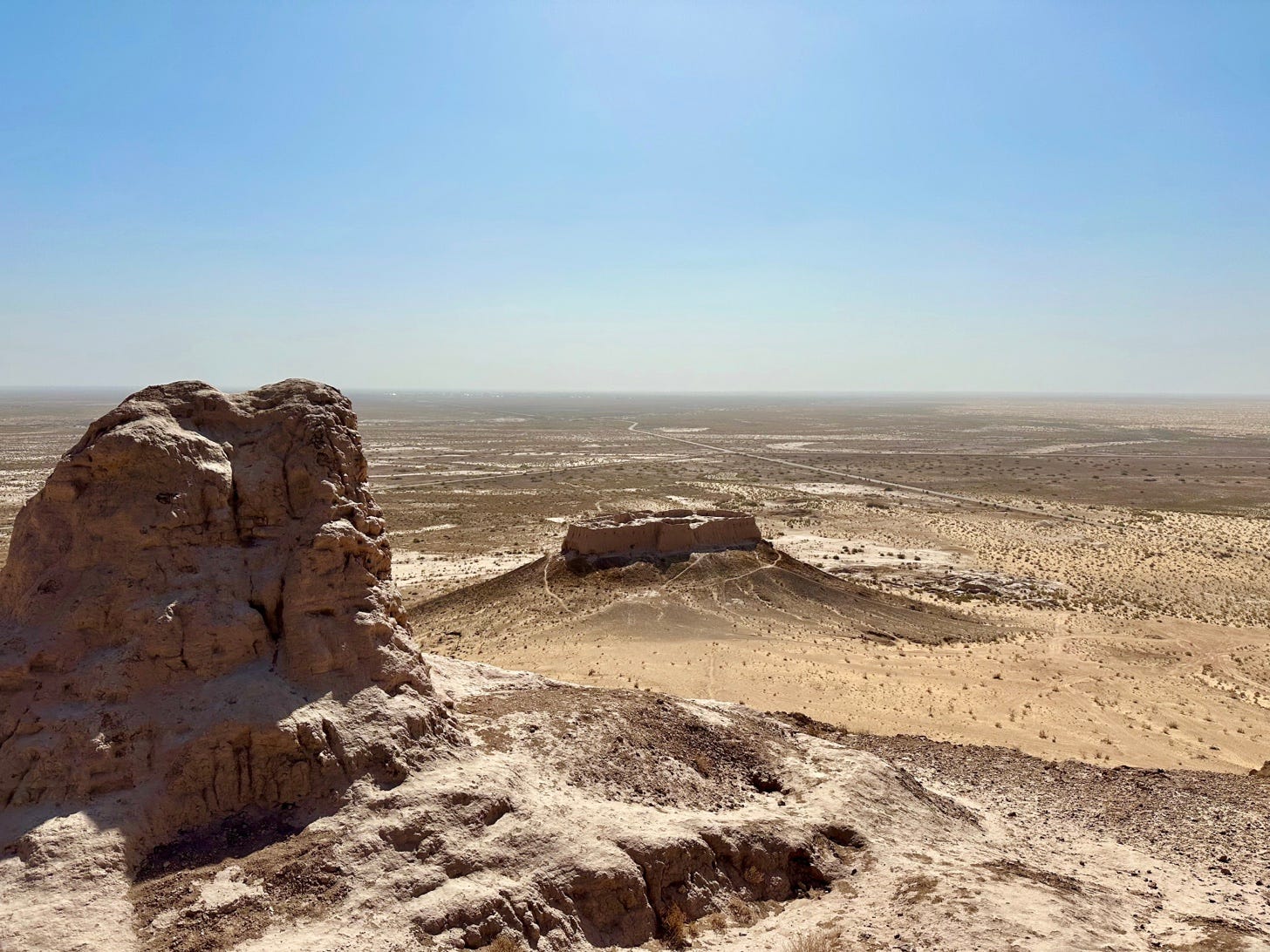
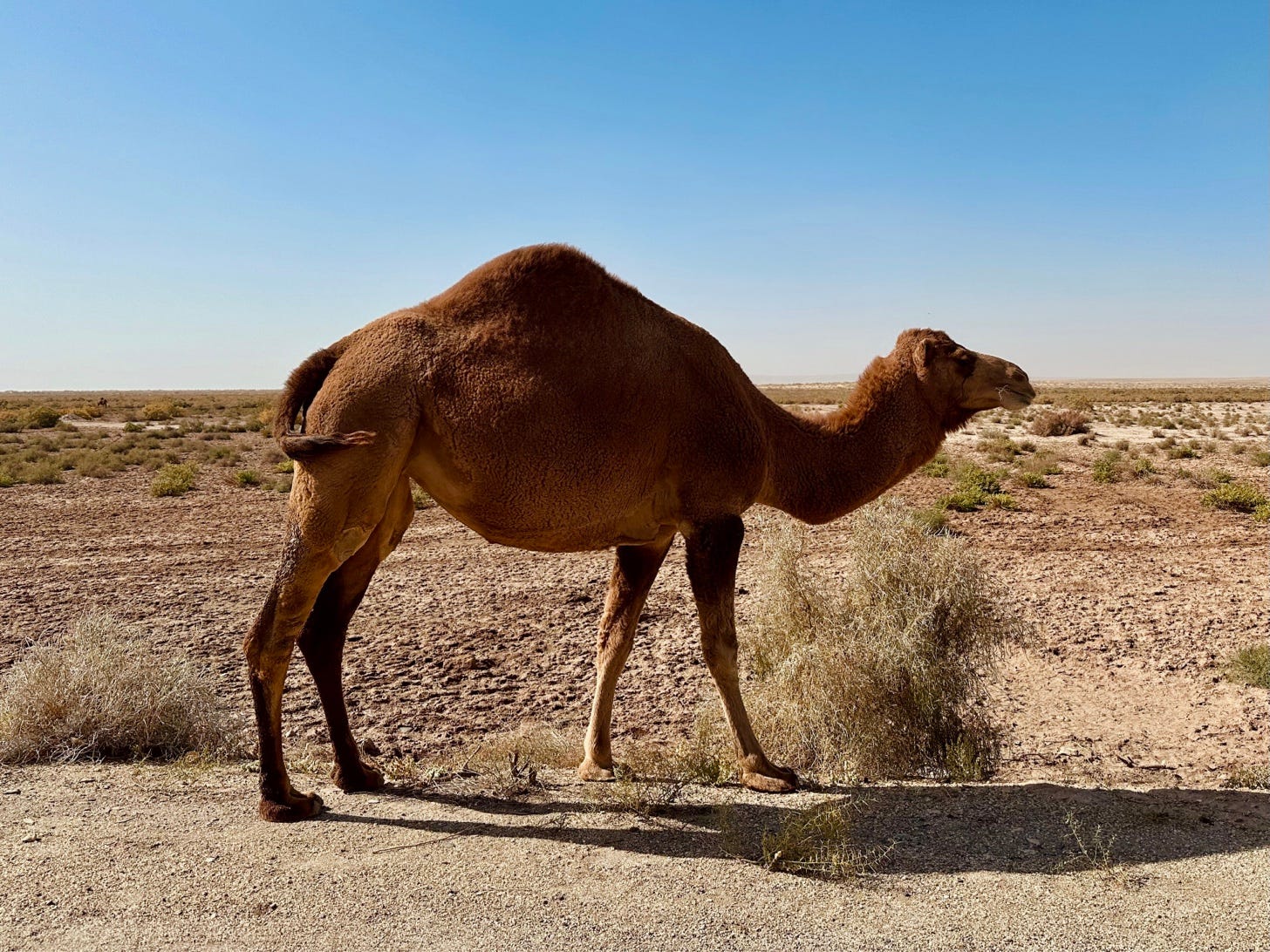
Toprak Kala
Kizil Kala

So much had changed in 11 years
While western economies and even the once unshakeable China all face stagnation Uzbekistan is on a tear. Since the death of the first president Islam Karimov the new President Shavkat Mirziyoyev has made major changes to the country’s economy.
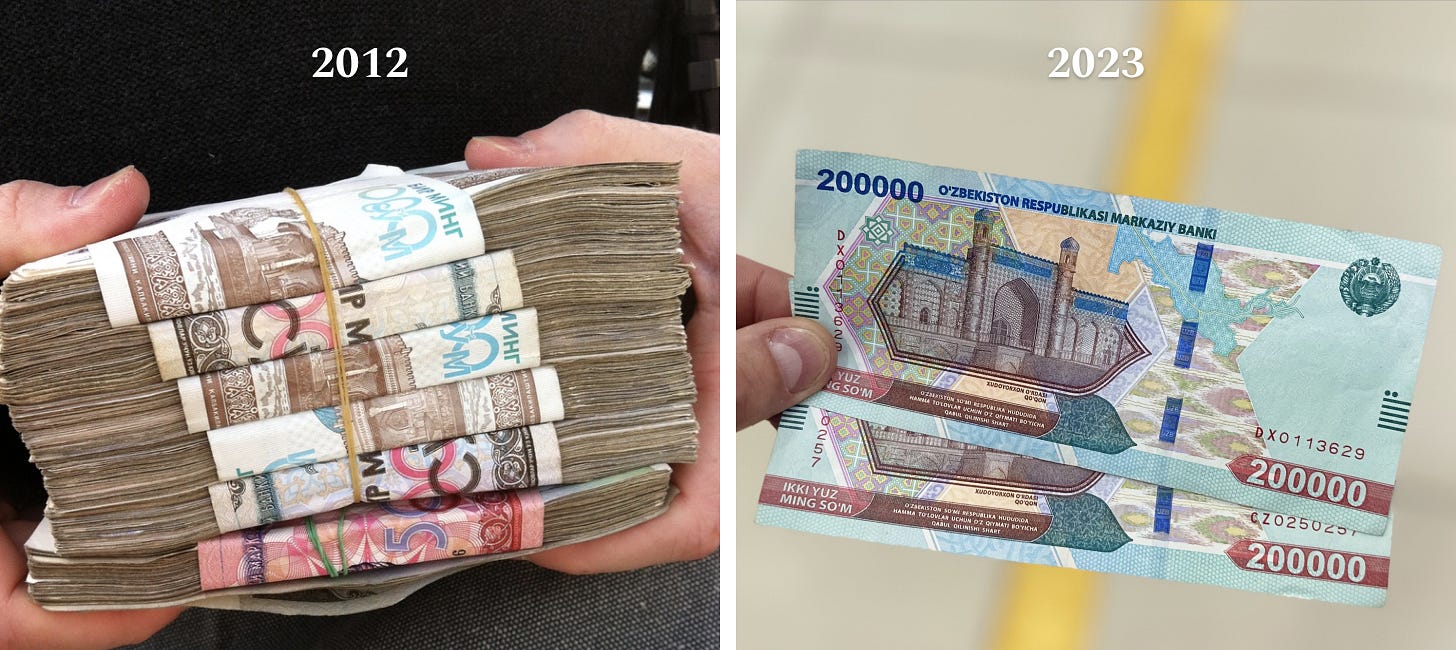
Last time I visited Uzbekistan, aside from a random French backpacker, I barely recall seeing any tourists. In 2023 things have changed a lot. In Khiva we saw coach loads of Spanish, Italian & French tourists, and along with them were dozens of stalls selling local souvenirs. Also perhaps due to the current geopolitical climate there were countless Russian tourists too. Uzbekistan seems to have done a lot to attract tourists, so many things were a lot easier with credit cards widely accepted. Similar to the London Underground, the Tashkent metro even supports contactless payments.

Uzbekistan felt like a country on the move. I felt energised hearing my friends talking about all the changes and progress happening. With heavy investment into education the country is trying to reduce its dependence on lower value exports like cotton and build a modern high tech economy. I’m already looking forward to my next visit.





